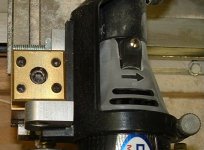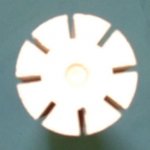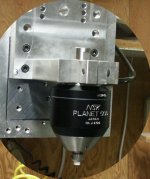You are using an out of date browser. It may not display this or other websites correctly.
You should upgrade or use an alternative browser.
You should upgrade or use an alternative browser.
The mighty Dremmel
- Thread starter td873
- Start date
td873 said:I don't currently have all the tools I would like, but I do have a dremmel that I would like to use for some tasks. I was just wondering what methods others have used to mount a dremmel to a toolpost? (or other mounting points for that matter...)
-td
One of the most important things in building cues is building proper equipment. The last few years there has been a great upsurge in lathes, tooling, vidio's and parts for making cues available to anyone who desires to build a cue. This availability has made it to simple to construct a cue with little knowledge. Not so many years ago, it was almost impossible to get into the "click" where other cuemakers would consider giving any good advice. There was no equipment designed to build cues. You had to decide what it was that you wanted to create, then try to design something to build it and then build that piece of equipment.
For many years, until I got a mill, the most used piece of equipment in my shop was a driil press as I was constantly adapting or building jigs and other equipment for a particuler purpose. The beauty of designing and building your own equipment is a full understanding of "What's going on". You learn a whole lot by making mistakes. There is no one right way to build a cue. There are many ways of curing wood, turning wood, joining wood and so on.
If you learn how to do something from a tape or book you only learn that persons way of doing things. Most of what I have learned has been thru trial and error. To this day my favorite passtime is talking to other cue makers to get their view point on a particuler operation in building a cue. I have my way of doing something and their way may be different and 10 times simpler.
Went off on a jag there but to get back to your question. There are many ways of mounting the Dremell to a lathe. You need to know what kind of toolpost you are using. Just lay the dremell along side your toolpost and determine at what height it needs to be and the mount could be as simple as a short piece of angle iron strapped to the body of the Dremell with hose clamps and mounted to the toolpost or it could be a little more complicated and a jig of some sort needs to be made. Either way it would be very simple to make.
I, myself, have found very little that a Dremell is good for in cue building. It really doesn't run quite true enough for the small end mills you usually use in cue building without excessive breakage. Even good laminate trimmers such as Porter Cable don't hold up very long and when purchasing these you've got to check the run out.
Dick
rhncue said:One of the most important things in building cues is building proper equipment. The last few years there has been a great upsurge in lathes, tooling, vidio's and parts for making cues available to anyone who desires to build a cue. This availability has made it to simple to construct a cue with little knowledge. Not so many years ago, it was almost impossible to get into the "click" where other cuemakers would consider giving any good advice. There was no equipment designed to build cues. You had to decide what it was that you wanted to create, then try to design something to build it and then build that piece of equipment.
For many years, until I got a mill, the most used piece of equipment in my shop was a driil press as I was constantly adapting or building jigs and other equipment for a particuler purpose. The beauty of designing and building your own equipment is a full understanding of "What's going on". You learn a whole lot by making mistakes. There is no one right way to build a cue. There are many ways of curing wood, turning wood, joining wood and so on.
If you learn how to do something from a tape or book you only learn that persons way of doing things. Most of what I have learned has been thru trial and error. To this day my favorite passtime is talking to other cue makers to get their view point on a particuler operation in building a cue. I have my way of doing something and their way may be different and 10 times simpler.
Went off on a jag there but to get back to your question. There are many ways of mounting the Dremell to a lathe. You need to know what kind of toolpost you are using. Just lay the dremell along side your toolpost and determine at what height it needs to be and the mount could be as simple as a short piece of angle iron strapped to the body of the Dremell with hose clamps and mounted to the toolpost or it could be a little more complicated and a jig of some sort needs to be made. Either way it would be very simple to make.
I, myself, have found very little that a Dremell is good for in cue building. It really doesn't run quite true enough for the small end mills you usually use in cue building without excessive breakage. Even good laminate trimmers such as Porter Cable don't hold up very long and when purchasing these you've got to check the run out.
Dick
I found that to be the case as well with Dremal. The motor and spindle runs true but it is loosely mounted in a plastic housing and wobbles inside making it very untrue. I found the same thing with Roto Zip. I got one at a garage sale and tried to use it to cut some slots and it had a 1/16 of an inch of wobble in it making it all but useless, again due to the plastic housing. The whole mechanical mechanism moves inside the plastic housing and there isn't any way to correct it, that's the way it's made.
I cut inlay parts and pockets with a Dremel tool. See my website and almost all the inlays you see were done with a Dremel tool. The Dremel can indeed be mighty if used correctly. Of course my Dremel is moved with a precision sliding system. Even on my CNC machine I use the commercial digital read out Dremel tool.
www.hightowercues.com
Chris
www.hightowercues.com
Chris
I have a B&D Wizard (generic Dremel), it came with a router atachment that is used to adjust depth of cut. The attachment is a two piece thing that I use only half of. I took a 1" square steel tube and drilled a hole through it to slide down over the tool post. Another hole was drilled at a 90 degree angle that allows bolting of the half of the router attachment. It is not sturdy at all, but it does a good job of grinding the ends of tread rod. With the buffing wheel, it does a good job of polishing stainless screws. Those are the only two things I have found it usefull for.rhncue said:I, myself, have found very little that a Dremell is good for in cue building. It really doesn't run quite true enough for the small end mills you usually use in cue building without excessive breakage.
Tracy
cueman said:I cut inlay parts and pockets with a Dremel tool. See my website and almost all the inlays you see were done with a Dremel tool. The Dremel can indeed be mighty if used correctly. Of course my Dremel is moved with a precision sliding system. Even on my CNC machine I use the commercial digital read out Dremel tool.
www.hightowercues.com
Chris
The ones I have used have been the two speed and variable speed ones in the $40. to $50. range. Because the bearings are mounted in the plastic housing they just seem to move around especially once they are over heated a few times in heavy use.. The more high end Dremel tools may not experience that problem or the housings may be better constructed. Have you ever built and machines using a heavy duty all steel spindle like a Foredom with a flex shaft? The ones I have used the spindles seem very high quality and precision.
http://www.blackstoneind.com/founda...ht=0&fspecial=&tspecial=&start=1&category=162
Last edited:
macguy said:The ones I have used have been the two speed and variable speed ones in the $40. to $50. range. Because the bearings are mounted in the plastic housing they just seem to move around especially once they are over heated a few times in heavy use.. The more high end Dremel tools may not experience that problem or the housings may be better constructed. Have you ever built and machines using a heavy duty all steel spindle like a Foredom with a flex shaft? The ones I have used the spindles seem very high quality and precision.
http://www.blackstoneind.com/founda...ht=0&fspecial=&tspecial=&start=1&category=162
I have a flex shaft on one tool I use for making indexing pulleys with. But I don't care for the flex hose as it seems to not run fast enough and it over heats easily. The digital read out dremel tools are pretty nice and can still be bought for about $80. They actually seem to run more consistant after a few hours of use than when brand new.
Chris
www.hightowercues.com
www.internationalcuemakers.com
The only thing I use a Dremel for is with a mini drum sander to clean up the gluing surface on phenolic rings. I just recently blew up the spindle on my CNC machine. The $2500 precise spindle I'd bought used on ebay didn't last too long. I replaced it this week with http://cgi.ebay.com/ws/eBayISAPI.dll?ViewItem&item=7517123698&rd=1&sspagename=STRK:MEWN:IT&rd=1
. The guy who makes these makes a more inexpensive model for about $100 that would replace a Dremel very well with much more accuracy. The brushless model I bought is much quieter than any other spindle or router I've seen and runs as true as anything I've ever seen. It should run a minimum of 1000 hours before it needs any service.
just more hot air!
Sherm
. The guy who makes these makes a more inexpensive model for about $100 that would replace a Dremel very well with much more accuracy. The brushless model I bought is much quieter than any other spindle or router I've seen and runs as true as anything I've ever seen. It should run a minimum of 1000 hours before it needs any service.
just more hot air!
Sherm
Looks like he's got a 300 watt model as well.
http://cgi.ebay.com/ws/eBayISAPI.dll?ViewItem&category=87080&item=7523823987
That thing compares to the NSK that sells for over 3K!
http://cgi.ebay.com/ws/eBayISAPI.dll?ViewItem&category=87080&item=7523823987
That thing compares to the NSK that sells for over 3K!
Sheldon said:Looks like he's got a 300 watt model as well.
http://cgi.ebay.com/ws/eBayISAPI.dll?ViewItem&category=87080&item=7523823987
That thing compares to the NSK that sells for over 3K!
The dremel is getting me by right now, they are just multipro variable speeds, and I have some, but no where near 1/16 runout with It, though sure time will wear on them.
I've been looking at those spindles on ebay also, are they any good? think they were 40,000 rpm. they are kind of pricy, but not compared to 3 grand, and I will have to step up to one before too long. Is that the same guy that has the website with all the cool machines he built from scrap? I have a link somewhere, he made spindles also. some sold to cuemakers.
I added of few pics of how I mounted Mine. I think we all agree the better the spindle the more precise, and I do want to upgrade to one, but this is getting me by until I can afford better. I started out making billet with the use of a wood lathe to mark my indexing, and on a cheap drill press with import slide mounted on It, so It's alot better then that. I just used parts from one of their router attatchments, milled it alittle to fit the piece of alloy tightly so I could mount that in the tool post, and slapped something together with what I had real quick to get me by for alittle while. Since It's centered with the tool post, all I have to do is make sure the bit lines up with the tip of center in the tailstock, and It's square. The tighter you make the mounts the less runout. Making sure the gibs on your crosslide are ajusted well also helps cut down on the runout. I also use It for cutting rings off, but not with the lathe powered up. I spin the headstock spindle By hand when cutting the rings.
This is not a long term thing, but since I already had an extra dremel I tried It out. Hope this helps, but I have to admitt, a good spindle would be better.
Thanks Greg
Greg
Attachments
Last edited:
Sheldon said:Here's what I use. I've seen a few of them on Ebay, all around 3-4 hundred.
It will do over 60K rpm on about 65lbs of air.
I had a Yuassa that was supposed to do 75,000 @80# but it would lose rpms after a short while and the exaust went straight down which kept all of the sawdust blown away but it also left the lube oil in the air on the cue. I'm presently using a variable speed (0-75,000) Precise high speed spindle and it's working quite well. I usually run at 1/2 speed which is about 35,000 rpm. It's not supposed to have any measurable runout down to a 100,000ths. I know my small endmills last 3 or 4 times longer now than when I was using a P/C lam. trimmer.
Dick
Hey Sherm,cuesmith said:The only thing I use a Dremel for is with a mini drum sander to clean up the gluing surface on phenolic rings. I just recently blew up the spindle on my CNC machine. The $2500 precise spindle I'd bought used on ebay didn't last too long. I replaced it this week with http://cgi.ebay.com/ws/eBayISAPI.dll?ViewItem&item=7517123698&rd=1&sspagename=STRK:MEWN:IT&rd=1
. The guy who makes these makes a more inexpensive model for about $100 that would replace a Dremel very well with much more accuracy. The brushless model I bought is much quieter than any other spindle or router I've seen and runs as true as anything I've ever seen. It should run a minimum of 1000 hours before it needs any service.
just more hot air!
Sherm
Let us know if it has the power to do the job and how it holds up.
Chris
> One of my other interests are guitars,and guitar repairmen and luthiers LOVE the Dremel,and are using it more and more as an actual router with the right attachments and templates. I will try and find this article about using either aluminum foil,.005 feeler guages or epoxy to supposedly tighten up the bearing's fit in the housing,apparently some of the better known luthiers also had complaints about vibration in the housing,and offers these ways of fixing it. This article was printed in a Stewart-McDonald Guitar Shop Supply catalog a couple years ago. These guys are pretty good people to deal with,and have several items that can cross over to cue repair/finishing/building. Tommy D.



